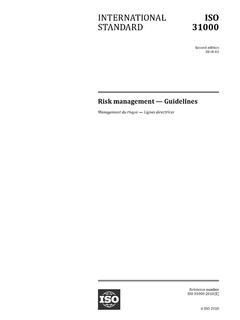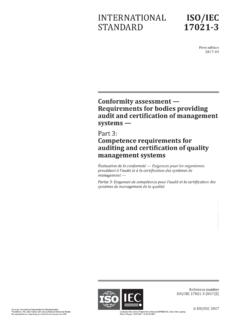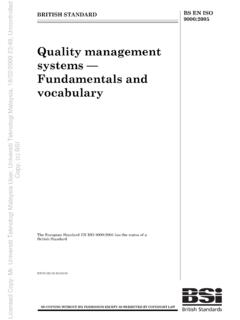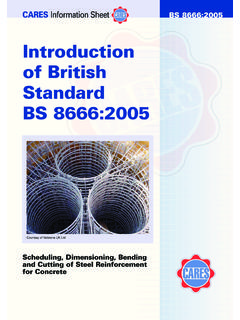Transcription of Safety of machinery — General principles for design — Risk ...
1 Raising standards worldwide NO COPYING WITHOUT BSI PERMISSION EXCEPT AS PERMITTED BY COPYRIGHT LAWBSI standards PublicationBS EN ISO 12100:2010 Safety of machinery General principles for design Risk assessment and risk reduction (ISO 12100:2010)Incorporating corrigendum January 2011BS EN ISO 12100:2010 british STANDARDN ational forewordThis british Standard is the UK implementation of EN ISO 12100:2010. It supersedes BS EN ISO 12100-1:2003+A1:2009, BS EN ISO 12100-2:2003+A1:2009 and BS EN ISO 14121-1:2007 which are UK participation in its preparation was entrusted to Technical Committee MCE/3, Safeguarding of list of organizations represented on this committee can be obtained on request to its standard was formed by combining the latest versions of ISO 12100-1:2003, ISO 12100-2:2003 and ISO 14121-1:2007 without introducing technical changes. Although efforts were made to maintain a balance between the emphases of these individual standards , some compromises have been made.
2 For example, whereas Clause 4 of ISO 12100-1 included requirements and supplementary information for hazard identification, ISO 12100 has adopted the approach of ISO 14121-1 by separating the requirements (see Subclause ) from supplementary information (see informative Annex B). This compromise in no way indicates that the identification of hazards has been given a reduced prominence, as it remains a vital stage in the process of designing safe publication does not purport to include all the necessary provisions of a contract. Users are responsible for its correct application. BSI 2011 ISBN 978 0 580 74262 0 ICS Compliance with a british Standard cannot confer immunity from legal british Standard was published under the authority of the standards Policy and Strategy Committee on 31 December 2010. Amendments issued since publicationDate Text affected31 January 2011 Correction to pagination EUROPEAN STANDARD NORME EUROP ENNE EUROP ISCHE NORM EN ISO 12100 November 2010 ICS Supersedes EN ISO 12100-1:2003, EN ISO 12100-2:2003, EN ISO 14121-1:2007 English Version Safety of machinery - General principles for design - Risk assessment and risk reduction (ISO 12100:2010) S curit des machines - Principes g n raux de conception - Appr ciation du risque et r duction du risque (ISO 12100:2010) Sicherheit von Maschinen - Allgemeine Gestaltungsleits tze - Risikobewertung und Risikominderung (ISO 12100:2010) This European Standard was approved by CEN on 9 October 2010.
3 CEN members are bound to comply with the CEN/CENELEC Internal Regulations which stipulate the conditions for giving this European Standard the status of a national standard without any alteration. Up-to-date lists and bibliographical references concerning such national standards may be obtained on application to the CEN-CENELEC Management Centre or to any CEN member. This European Standard exists in three official versions (English, French, German). A version in any other language made by translation under the responsibility of a CEN member into its own language and notified to the CEN-CENELEC Management Centre has the same status as the official versions. CEN members are the national standards bodies of Austria, Belgium, Bulgaria, Croatia, Cyprus, Czech Republic, Denmark, Estonia, Finland, France, Germany, Greece, Hungary, Iceland, Ireland, Italy, Latvia, Lithuania, Luxembourg, Malta, Netherlands, Norway, Poland, Portugal, Romania, Slovakia, Slovenia, Spain, Sweden, Switzerland and United Kingdom.
4 EUROPEAN COMMITTEE FOR STANDARDIZATION COMIT EUROP EN DE NORMALISATION EUROP ISCHES KOMITEE F R NORMUNG Management Centre: Avenue Marnix 17, B-1000 Brussels 2010 CEN All rights of exploitation in any form and by any means reserved worldwide for CEN national Members. Ref. No. EN ISO 12100:2010: EThis page deliberately left blankBS EN ISO 12100:2010EN ISO 12100:2010 (E) 3 Foreword This document (EN ISO 12100:2010) has been prepared by Technical Committee ISO/TC 199 " Safety of machinery " in collaboration with Technical Committee CEN/TC 114 Safety of machinery the secretariat of which is held by DIN. This European Standard shall be given the status of a national standard, either by publication of an identical text or by endorsement, at the latest by May 2011, and conflicting national standards shall be withdrawn at the latest by November 2013. Attention is drawn to the possibility that some of the elements of this document may be the subject of patent rights.
5 CEN [and/or CENELEC] shall not be held responsible for identifying any or all such patent rights. This document supersedes EN ISO 12100-1:2003, EN ISO 12100-2:2003, EN ISO 14121-1:2007. This second edition cancels and replaces ISO 12100-1:2003, ISO 12100-1:2003/Amd. 1: 2009, ISO 12100-2:2003, ISO 12100-2:2003/Amd. 1: 2009 and ISO 14121-1:2007 of which it constitutes a consolidation without technical changes. Documentation ( risk assessment, type-C standards ) based on these replaced documents need not be updated or revised. This document has been prepared under a mandate given to CEN by the European Commission and the European Free Trade Association, and supports essential requirements of EU Directive(s). For relationship with EU Directive(s), see informative Annex ZA, which is an integral part of this document. According to the CEN/CENELEC Internal Regulations, the national standards organizations of the following countries are bound to implement this European Standard: Austria, Belgium, Bulgaria, Croatia, Cyprus, Czech Republic, Denmark, Estonia, Finland, France, Germany, Greece, Hungary, Iceland, Ireland, Italy, Latvia, Lithuania, Luxembourg, Malta, Netherlands, Norway, Poland, Portugal, Romania, Slovakia, Slovenia, Spain, Sweden, Switzerland and the United Kingdom.
6 Endorsement notice The text of ISO 12100:2010 has been approved by CEN as a EN ISO 12100:2010 without any modification. BS EN ISO 12100:2010EN ISO 12100:2010 (E) 4 Annex ZA (informative) Relationship between this European Standard and the Essential Requirements of EC Directive 2006/42/EC This European Standard has been prepared under a mandate given to CEN by the European Commission [and the European Free Trade Association] to provide a means of conforming to Essential Requirements of the New Approach Directive machinery , 2006/42/EC. Once this standard is cited in the Official Journal of the European Union under that Directive and has been implemented as a national standard in at least one Member State, compliance with the normative clauses of this standard confers, within the limits of the scope of this standard, a presumption of conformity with the relevant Essential Requirements of that Directive and associated EFTA regulations.
7 WARNING Other requirements and other EU Directives may be applicable to the product(s) falling within the scope of this standard. BS EN ISO 12100:2010 ISO 12100:2010(E) ISO 2010 All rights reserved iii Contents Page Foreword .. v vi 1 Scope .. 1 2 Normative 1 3 Terms and definitions .. 1 4 Strategy for risk assessment and risk reduction .. 9 5 Risk assessment ..12 General .. 12 Information for risk assessment ..12 Determination of limits of machinery ..13 General .. 13 Use 13 Space Time limits .. 14 Other 14 Hazard identification ..14 Risk estimation ..16 General .. 16 Elements of Aspects to be considered during risk estimation ..19 Risk evaluation ..21 General .. 21 Adequate risk reduction ..21 Comparison of 6 Risk General .. 22 Inherently safe design General .. 23 Consideration of geometrical factors and physical aspects ..23 Taking into account General technical knowledge of machine design .
8 24 Choice of appropriate technology ..25 Applying principle of positive mechanical Provisions for Provisions for maintainability ..26 Observing ergonomic principles ..26 Electrical hazards ..27 Pneumatic and hydraulic hazards ..27 Applying inherently safe design measures to control systems ..28 Minimizing probability of failure of Safety functions ..33 Limiting exposure to hazards through reliability of equipment ..33 Limiting exposure to hazards through mechanization or automation of loading (feeding)/ unloading (removal) Limiting exposure to hazards through location of setting and maintenance points outside danger zones ..34 Safeguarding and complementary protective measures ..34 General .. 34 Selection and implementation of guards and protective devices ..35 Requirements for design of guards and protective Safeguarding to reduce BS EN ISO 12100:2010 ISO 12100:2010(E) iv ISO 2010 All rights reserved Complementary protective 44 Information for use.
9 46 General 46 Location and nature of information for use .. 46 Signals and warning 46 Markings, signs (pictograms) and written 47 Accompanying documents (in particular instruction handbook) .. 48 7 Documentation of risk assessment and risk 51 Annex A (informative) Schematic representation of a machine .. 52 Annex B (informative) Examples of hazards, hazardous situations and hazardous events .. 53 Annex C (informative) Trilingual lookup and index of specific terms and expressions used in ISO 63 Bibliography .. 75 BS EN ISO 12100:2010 ISO 12100:2010(E) ISO 2010 All rights reserved v Foreword ISO (the International Organization for Standardization) is a worldwide federation of national standards bodies (ISO member bodies). The work of preparing International standards is normally carried out through ISO technical committees. Each member body interested in a subject for which a technical committee has been established has the right to be represented on that committee.
10 International organizations, governmental and non-governmental, in liaison with ISO, also take part in the work. ISO collaborates closely with the International Electrotechnical Commission (IEC) on all matters of electrotechnical standardization. International standards are drafted in accordance with the rules given in the ISO/IEC Directives, Part 2. The main task of technical committees is to prepare International standards . Draft International standards adopted by the technical committees are circulated to the member bodies for voting. Publication as an International Standard requires approval by at least 75 % of the member bodies casting a vote. Attention is drawn to the possibility that some of the elements of this document may be the subject of patent rights. ISO shall not be held responsible for identifying any or all such patent rights. ISO 12100 was prepared by Technical Committee ISO/TC 199, Safety of machinery .









